Loose Incense - Why and How?
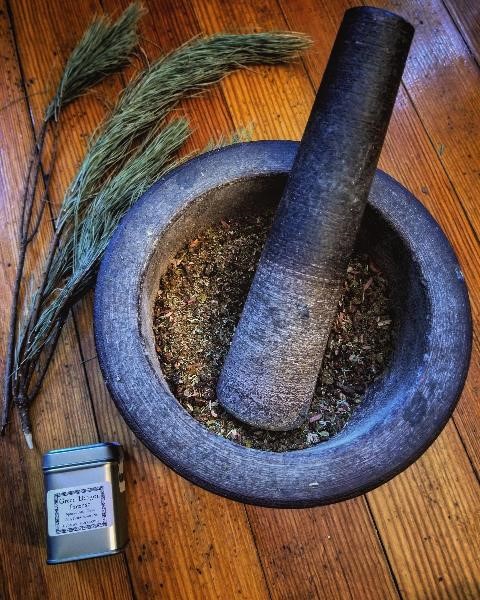
Loose incense is the oldest and most traditional form of incense. It takes a bit more effort to burn, but that effort is richly rewarded. Unlike most standard, store-bought incenses which are full of chemicals and ground up in machines at factory warehouses, every single batch of Alchemy Works incense is hand-ground using only natural, botanical materials. We use a consecrated stone mortar and pestle for each batch that we craft and we blend only a few ounces at a time.
We blend our incense in our working, sanctified temple space. We also pay attention to planetary hours, astrological portents, and other spiritual frameworks (including our own mindsets) to ensure that each blend is crafted with maximal potency.
In addition to being ritually hand-crafted by a working occultist and containing only natural plant materials, Alchemy Works' loose incense also provides for a more dynamic experience while burning. Unlike stick incense, which only provides a single scent and intensity, loose incense contains a blend of separate plant materials that are ground to different consistencies. This means that a loose incense has a general tone or gestalt, but that within the tone are layers of unique botanical scents that vary widely. As different bits of resin, herbs, and flowers come into contact with the heat, they smolder and release their individual fragrances, thus engendering a complex and layered olfactory experience that is constantly transforming throughout the burn.
Burning Incense Using Charcoal
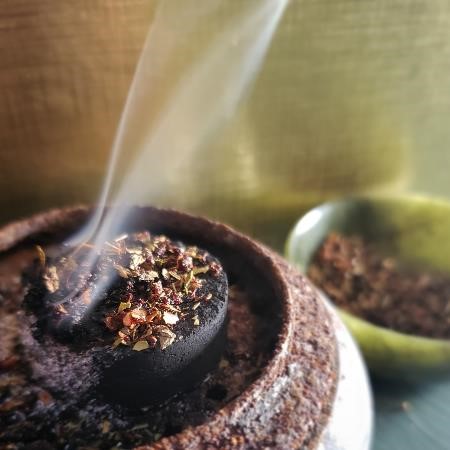 We recommend burning your incense using all-natural charcoal tablets or discs. (Shoyeido offers excellent all-natural charcoals in various sizes, as do several other companies in Japan, where incense is both an art and an important spiritual practice.) Though all-natural charcoals take longer to light and are a bit more expensive, they don't contain the toxic substances that the quick-light ones do. Once your charcoal is fully lit (the natural ones take 30-60 seconds over a candle flame or gas stove) with a good portion glowing red, just sprinkle your loose incense onto the heat and let the magic begin! Be sure not to bury the sides in the sand or ash below the charcoal so that it has plenty of oxygen for combustion.
We recommend burning your incense using all-natural charcoal tablets or discs. (Shoyeido offers excellent all-natural charcoals in various sizes, as do several other companies in Japan, where incense is both an art and an important spiritual practice.) Though all-natural charcoals take longer to light and are a bit more expensive, they don't contain the toxic substances that the quick-light ones do. Once your charcoal is fully lit (the natural ones take 30-60 seconds over a candle flame or gas stove) with a good portion glowing red, just sprinkle your loose incense onto the heat and let the magic begin! Be sure not to bury the sides in the sand or ash below the charcoal so that it has plenty of oxygen for combustion.
We are often asked what type of charcoal burner is best for loose incense. The answer to this question varies but ultimately comes down to where you plan to burn your incense and what you have on hand. We have several burners that we use regularly. When we're burning incense outside, we like to use a burner with a perforated lid to protect the incense/charcoal from the wind. We have one made of wood with a metal piece in the interior that holds the charcoal. 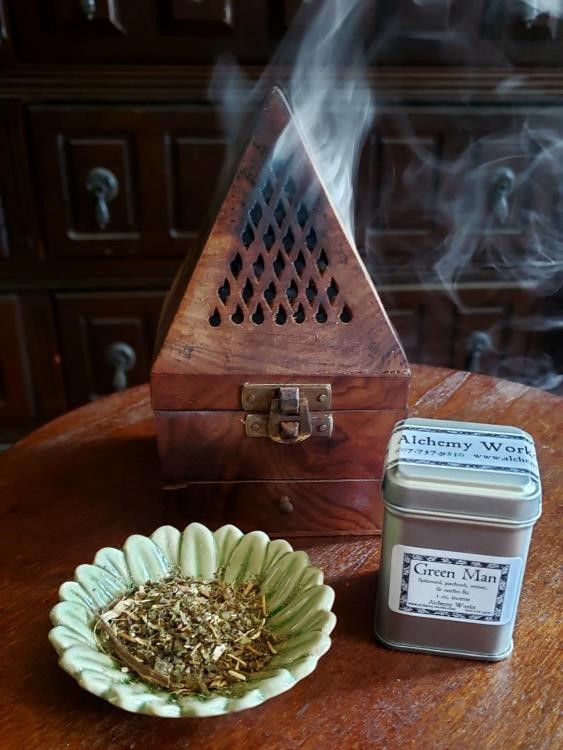 We also use a small, lidded cauldron, which we fill halfway with sand or pebbles (dirt also works) before placing the charcoal. You can burn the incense without the lid, but if you need to quickly stop the smoke, having a lid is a great option. Indoors, we have several incense bowls that come with a heat-safe stand (wood, silicone, etc.) and a screen. Place the bowl on the stand, screen on the bowl, burning charcoal on the screen, and the incense onto the charcoal. The ash and burnt incense will fall into the bowl, which you can easily empty after everything cools. If you don't have any of these on hand, you can also use a simple ceramic mug. Fill the mug halfway with sand or dirt, then place the burning charcoal on it making sure that the charcoal doesn't touch the sides of the mug. Place the incense on the charcoal and - voila - you have a portable incense burner. This is a great option if you are working with your ancestors and have a mug that belonged to them. (You can still use the mug for beverages again later, as long as you used enough sand, the mug will not be affected at all).
We also use a small, lidded cauldron, which we fill halfway with sand or pebbles (dirt also works) before placing the charcoal. You can burn the incense without the lid, but if you need to quickly stop the smoke, having a lid is a great option. Indoors, we have several incense bowls that come with a heat-safe stand (wood, silicone, etc.) and a screen. Place the bowl on the stand, screen on the bowl, burning charcoal on the screen, and the incense onto the charcoal. The ash and burnt incense will fall into the bowl, which you can easily empty after everything cools. If you don't have any of these on hand, you can also use a simple ceramic mug. Fill the mug halfway with sand or dirt, then place the burning charcoal on it making sure that the charcoal doesn't touch the sides of the mug. Place the incense on the charcoal and - voila - you have a portable incense burner. This is a great option if you are working with your ancestors and have a mug that belonged to them. (You can still use the mug for beverages again later, as long as you used enough sand, the mug will not be affected at all).
Because charcoal becomes very hot, you should always use tongs. This is true for lighting the charcoal and also for sprinkling your incense onto it. If you notice that your charcoal is covered in ashes, use your tongs to scrape them off before adding new incense. Be sure to use caution, especially with charcoal that has been burning for a while. We also advise you to protect the surfaces upon which you place your burner - they can get hot! (This is true for a cauldron as well, and sometimes a mug, depending on how much sand you've used). If you plan to move your incense around the room, we suggest placing a large heat-safe plate (or one with a handle) under your burner, which allows you to easily bring it from room to room. Top
Burning Incense Using an Electric Incense Burner or Oil Warmer
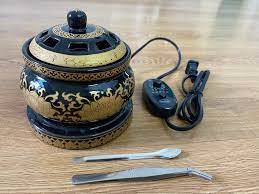 If you cannot light incense in your home or prefer a smokeless way to release the scent, we suggest using an electric incense burner (sometimes called a resin burner, bakhoor burner, or incense heater). Electric burners allow you to enjoy the aroma of your incense without accompanying smoke. The scent that is released is much closer to its initial "raw" fragrance in the tin. Some electric burners have an adjustable thermostat and other have only an on/off switch. Because each incense is different, plant materials combust at different temperatures, and individual olfactory preferences vary, if you have the option, we suggest experimenting with the temperature of your burner until you find what is right for you and the incense you are burning. We have found that a range of 170-220 ℉ works best.
If you cannot light incense in your home or prefer a smokeless way to release the scent, we suggest using an electric incense burner (sometimes called a resin burner, bakhoor burner, or incense heater). Electric burners allow you to enjoy the aroma of your incense without accompanying smoke. The scent that is released is much closer to its initial "raw" fragrance in the tin. Some electric burners have an adjustable thermostat and other have only an on/off switch. Because each incense is different, plant materials combust at different temperatures, and individual olfactory preferences vary, if you have the option, we suggest experimenting with the temperature of your burner until you find what is right for you and the incense you are burning. We have found that a range of 170-220 ℉ works best.
Depending on the incense and the heat setting of your burner, you may see vapor rising from the blend while you heat it. When your loose incense has released all its fragrance, instead of leaving ashes behind, the ingredients will become black, dry and brittle, and a dark, sticky reside will be left behind in the burning tray. To protect your burner, we suggest placing your incense into a foil bowl and placing that upon the burner itself. We save and use our old tealights for this purpose–just scrape out any remaining wax, sprinkle in a little incense, and place it on the heat. 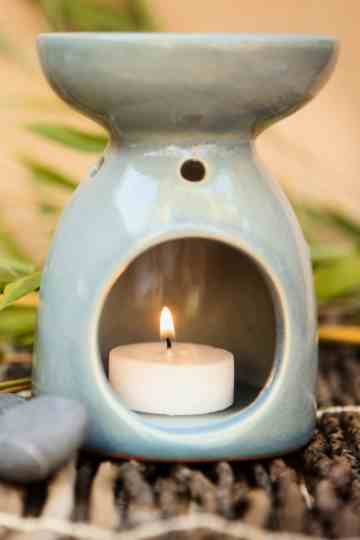 When the incense is burnt and dry, just throw the whole thing away. You can also use tin foil.
When the incense is burnt and dry, just throw the whole thing away. You can also use tin foil.
An oil warmer and a tealight will also work to release some of the incense's fragrance. This option won't deliver as much heat, so you won't get the full aroma, but it works in a pinch. Just put the incense in the bowl and light the tealight below it. (We suggest lining the bowl with foil first.) You can also put water into the bowl and mix in some incense. The hot vapor from the water will carry the aroma (but be sure not to let the water burn off entirely because it's a pain to clean out the bowl after this happens). Top
Burning Incense Without a Burner
If you don't have an incense burner, are out of charcoals, or just want to do a quick burn, you can pour a small amount of loose incense into a fireproof bowl and light it using a lighter, matches, or a waxed hemp wick. You can use a candle, too, but wax will drip into your bowl and your incense blend. Keep the flame on the incense until the incense itself flames, then blow it out, allowing the incense to smolder and release it's fragrance. Some people like to use an abalone shell for this purpose, which works fine, but be aware that burning herbs and resins will leave marks on the pearl. Top
Potpourri, Strewn Offering, or Candle Dressing
All Alchemy Works incenses are also designed as potpourri. If your climate, health or living situation prevent you from burning incense, a bowl of potpourri can still help to sanctify and freshen your living space, shrine, or altar. We personally also like to keep a small mortar and pestle filled with incense/potpourri offerings in certain shrines and give them a fresh grind before or during meditation or devotional practices.
Additionally, the nature of loose incense allows one to also use it for strewed offerings. Since there are no artificial or synthetic ingredients in our blends it does no harm if you leaving a little bit at the base of a special tree or sprinkle some into a running stream. You can also use incense as an additional layer to candle dressing. After applying sacred oil to a spell candle, roll it in a thin layer of incense to coat and charge the candle with extra potency. Top
© 2021-2024 Alchemy Works; No reproduction without permission
Alchemy Works products are offered for use in spiritual, ritual, meditative, and magical practices, not for medicinal or cosmetic purposes. The information on this website is provided for its folkloric, historic, and magical value. It is not intended to be a substitute for professional medical advice, diagnosis, or treatment.